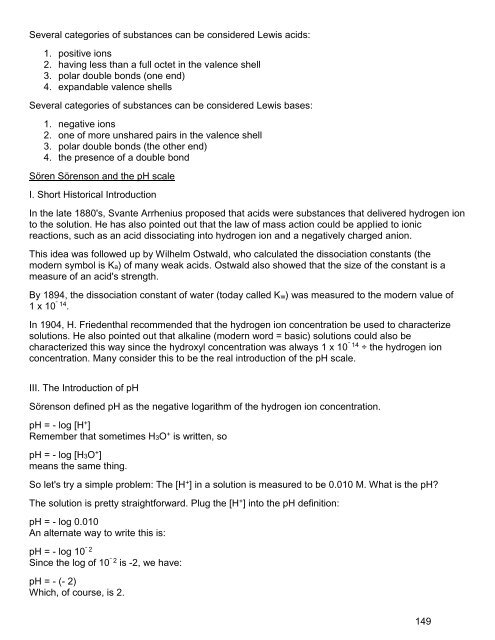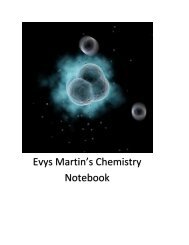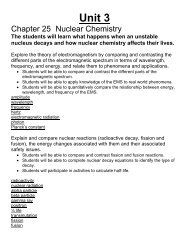You also want an ePaper? Increase the reach of your titles
YUMPU automatically turns print PDFs into web optimized ePapers that Google loves.
Several categories of substances can be considered Lewis acids:<br />
1. positive ions<br />
2. having less than a full octet in the valence shell<br />
3. polar double bonds (one end)<br />
4. expandable valence shells<br />
Several categories of substances can be considered Lewis bases:<br />
1. negative ions<br />
2. one of more unshared pairs in the valence shell<br />
3. polar double bonds (the other end)<br />
4. the presence of a double bond<br />
Sören Sörenson and the pH scale<br />
I. Short Historical Introduction<br />
In the late 1880's, Svante Arrhenius proposed that acids were substances that delivered hydrogen ion<br />
to the solution. He has also pointed out that the law of mass action could be applied to ionic<br />
reactions, such as an acid dissociating into hydrogen ion and a negatively charged anion.<br />
This idea was followed up by Wilhelm Ostwald, who calculated the dissociation constants (the<br />
modern symbol is Ka) of many weak acids. Ostwald also showed that the size of the constant is a<br />
measure of an acid's strength.<br />
By 1894, the dissociation constant of water (today called Kw) was measured to the modern value of<br />
1 x 10¯14 .<br />
In 1904, H. Friedenthal recommended that the hydrogen ion concentration be used to characterize<br />
solutions. He also pointed out that alkaline (modern word = basic) solutions could also be<br />
characterized this way since the hydroxyl concentration was always 1 x 10¯14 ÷ the hydrogen ion<br />
concentration. Many consider this to be the real introduction of the pH scale.<br />
III. The Introduction of pH<br />
Sörenson defined pH as the negative logarithm of the hydrogen ion concentration.<br />
pH = - log [H + ]<br />
Remember that sometimes H3O + is written, so<br />
pH = - log [H3O + ]<br />
means the same thing.<br />
So let's try a simple problem: The [H + ] in a solution is measured to be 0.010 M. What is the pH?<br />
The solution is pretty straightforward. Plug the [H + ] into the pH definition:<br />
pH = - log 0.010<br />
An alternate way to write this is:<br />
pH = - log 10¯2<br />
Since the log of 10¯2 is -2, we have:<br />
pH = - (- 2)<br />
Which, of course, is 2.








